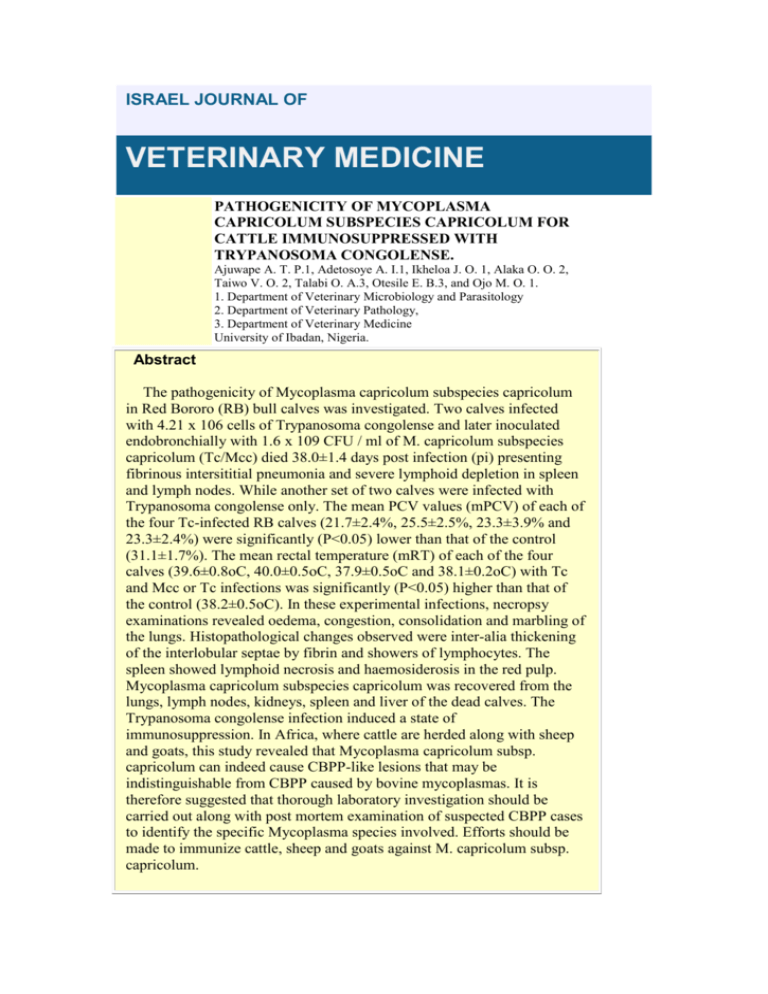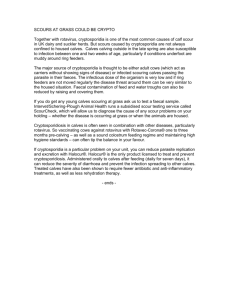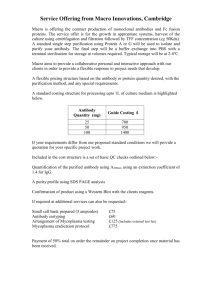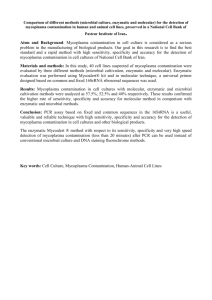pathogenicity of mycoplasma capricolum subspecies capricolum for
advertisement

ISRAEL JOURNAL OF VETERINARY MEDICINE Vol. 59 (4) 2003 PATHOGENICITY OF MYCOPLASMA CAPRICOLUM SUBSPECIES CAPRICOLUM FOR CATTLE IMMUNOSUPPRESSED WITH TRYPANOSOMA CONGOLENSE. Ajuwape A. T. P.1, Adetosoye A. I.1, Ikheloa J. O. 1, Alaka O. O. 2, Taiwo V. O. 2, Talabi O. A.3, Otesile E. B.3, and Ojo M. O. 1. 1. Department of Veterinary Microbiology and Parasitology 2. Department of Veterinary Pathology, 3. Department of Veterinary Medicine University of Ibadan, Nigeria. Abstract The pathogenicity of Mycoplasma capricolum subspecies capricolum in Red Bororo (RB) bull calves was investigated. Two calves infected with 4.21 x 106 cells of Trypanosoma congolense and later inoculated endobronchially with 1.6 x 109 CFU / ml of M. capricolum subspecies capricolum (Tc/Mcc) died 38.0±1.4 days post infection (pi) presenting fibrinous intersititial pneumonia and severe lymphoid depletion in spleen and lymph nodes. While another set of two calves were infected with Trypanosoma congolense only. The mean PCV values (mPCV) of each of the four Tc-infected RB calves (21.7±2.4%, 25.5±2.5%, 23.3±3.9% and 23.3±2.4%) were significantly (P<0.05) lower than that of the control (31.1±1.7%). The mean rectal temperature (mRT) of each of the four calves (39.6±0.8oC, 40.0±0.5oC, 37.9±0.5oC and 38.1±0.2oC) with Tc and Mcc or Tc infections was significantly (P<0.05) higher than that of the control (38.2±0.5oC). In these experimental infections, necropsy examinations revealed oedema, congestion, consolidation and marbling of the lungs. Histopathological changes observed were inter-alia thickening of the interlobular septae by fibrin and showers of lymphocytes. The spleen showed lymphoid necrosis and haemosiderosis in the red pulp. Mycoplasma capricolum subspecies capricolum was recovered from the lungs, lymph nodes, kidneys, spleen and liver of the dead calves. The Trypanosoma congolense infection induced a state of immunosuppression. In Africa, where cattle are herded along with sheep and goats, this study revealed that Mycoplasma capricolum subsp. capricolum can indeed cause CBPP-like lesions that may be indistinguishable from CBPP caused by bovine mycoplasmas. It is therefore suggested that thorough laboratory investigation should be carried out along with post mortem examination of suspected CBPP cases to identify the specific Mycoplasma species involved. Efforts should be made to immunize cattle, sheep and goats against M. capricolum subsp. capricolum. Introduction Mycoplasma capricolum subspecies capricolum has been reported as an agent of pneumonia in goats (1, 2) causing high mortality (1) and consequent severe economic losses and shortage of animal protein. This organism has also been incriminated as causative agent of sheep pneumonia with high mortality (2). However, this pathogen has been isolated from the external ears of normal goats (3, 4). The population of goats, sheep and cattle in the northern states of Nigeria was given as 34.45 million, 22.2 million and 13.99 million respectively (5). While, recent information suggests that rinderpest is on the verge of being eradicated in Nigeria, the incidence of CBPP is on the increase (6). Although cattle are vaccinated annually against CBPP in Nigeria, sporadic outbreaks are still observed, especially in some Northern States of Nigeria such as Kaduna, Borno, Sokoto, Bauchi, Kano and Kastina (7, 8, 9). It is relevant to note that in those states, ruminants are raised in close association, co-mingling. This type of animal husbandry system enhances the risk of transmission of disease pathogens between different species, as well as intra- species transmission. This may explain why M. capricolum subsp. capricolum may be harvested from bovines (10). Materials and Methods Mycoplasma organism Mycoplasma capricolum subspecies capricolum recovered from pneumonic lungs of goats slaughtered in Northern Nigeria was used for this study(11). The biochemical characteristics of the isolate viz sensitivity to digitonin, fermentation of glucose, hydrolysis of arginine, reduction of tetrazolium chloride in liquid media, digestion of serum, negative phosphatase activity, and no formation of film and spots indicated that the isolate is Mycoplasma capricolum subspecies capricolum Calif. Kid (12). Also the isolate was identified serologically to be Mycoplasma capricolum subspecies capricolum. The National Institute of Trypanosomiasis Research, Vom, Plateau State, Nigeria supplied the Trypanosoma congolense used in this study. The T. congolense was passaged in mice before inoculation. When the parasitaemia was high (4.21 x 106/CFU/ml), the trypanosomes were harvested. Animals: Five Red Bororo bull calves, about 12 months old were purchased from a farm in Sokoto, Sokoto State, Nigeria where there was no history of contagious bovine pleuropneumonia, brucellosis and rinderpest. The calves were transported to Ibadanand housed at the large animal facilities of the Veterinary Teaching Hospital, University of Ibadan. The animals were kept in 3.96m x 3.96m concrete pens and treated with diaminazene aceturate (Berenil®) intramuscularly at a dose rate of 5.0mg/10kg body weight (BW) against haemoparasites (Trypanosoma and Babesia) and dewormed orally with tetramizole (Nilverm® ICI Pharmaceutical, UK) at a dose rate of 66mg/kg BW. They were allowed to acclimatize for 4 weeks, after which the animals were confirmed negative for the presence of haemoparasites especially Babesia, Trypanosoma and Anasplasma species and intestinal helminthes by standard methods (13,14). With the aid of sterile swabs, clinical samples were obtained from the eyes, ears, nostrils and rectum of each calf and examined microbiologically for Mycoplasma (15, 16) and other bacteria (17). Pathogenicity test: Four Red Bororo bull calves were respectively inoculated with 4.21 x 106 trypanosome cells per milliliter of T. congolense intravenously through the jugular vein. Blood samples were collected from each bull every three days through the jugular vein to determine the level of parasitaemia. Also the PCV of each bull calf was determined by standard methods (14). The temperature and clinical signs of each calf were observed daily. Inoculation of Mycoplasma capricolum subspecies capricolum: When the PCV of each bull calf was 20% or slightly below, two of the bull calves were endobronchially inoculated as previously described elsewhere (18) with 10 ml of 1.6 x 109 CFU/ml of Mycoplasma capricolum subspecies capricolum, propagated in medium N (15, 16) after incubation at 37o C for 4 days. Another, group of two bull calves inoculated intravenously with 4.21 x 106 T. congolense / ml. served as controls for Trypanosome-infected calves. The PCV values of the calves were monitored till the PCV values fell to 20% and below at which point they were treated with diaminazene aceturate (Berenil) intramuscularly, at a dose - of 5.0mg/10kg body weight (BW). The remaining calf was inoculated endobronchially with sterile medium N served as negative control. Results The 2 Red Bororo bull calves infected with 4.21 x 106 T. congolense cells / ml. and later followed by endobronchial inoculation with 1.6 x 109 CFU / ml of Mycoplasma capricolum subspecies capricolum when their PCV values dropped to 20% respectively, died 36.0±2.1 days post infection (pi) The mean PCV values of each of the four calves (RB191, RB192; RB193 and RB194) inoculated with T. congolense were significantly lower (P<0.05) than the value for RB196 which was not infected with T. congolense. The PCV values of calves (RB193 and RB194) that were infected with T. congolense and were subsequently treated with Berenil® did not return fully to the original values up to 14 days pi despite the fact that no parasite was found in the blood sample (Table 1). This agrees with the observation of Dargie et al. (1979) that the PCV shows little tendency to recover even when parasites are undetectable for up to four months post-infection with trypanosome. However, the mean rectal temperatures of RB191 and RB192 respectively was significantly higher than the control calf RB196 as well as rb193 and rb194 which were infected with T. congolense and were subsuqeuntly treated with Berenil (Table 1). At necropsy the calves showed pale oedematous pneumonic lungs, grossly characterized by consolidation and marbling especially at the diaphragmatic lobes. Also the mediastinal lymph nodes were haemorrhagic and haemorrhages were seen in the heart. Furthermore, foci of necrosis were found in the kidneys and the synovial fluid from the joints of these animals possessed amber coloration. However, the liver and spleen of the respective calves looked normal grossly. The histopathological changes included congestion and oedema of the lungs (Fig. 1). Histopathological sections of the lungs showed thickening of the interlobular septae by fibrin and showers of mononuclear lymphocytes. The spleen showed marked lymphoid necrosis and haemosiderosis in the red pulp. There was extensive lymphoid depletion in the peri-arteriolar lymphoid sheaths (PALS) (Fig. 2). Also the lymph nodes showed severe haemosiderosis, erythrophagocytosis and lymphoid depletion. The kidneys had multifocal interstitial lymphocytic infiltrations (Fig. 3a and 3b). Mycoplasma capricolum subspecies capricolum was recovered from the lungs, liver, lymph nodes, spleen and kidneys, using standard methods (15, 16). The calves given 4.21 x 106 T. congolense / ml. and treated with diaminzene aceturate (Berenil), intramuscularly recovered completely around 7 days post-treatment, and the PCV values by that time had risen from 20% to 25%. However, the calf endobronchially inoculated with 10ml sterile medium N showed no clinical signs of disease and the body temperature was 38.2±0.5oC, and no Mycoplasma capricolum subspecies capricolum was recovered from this animal. Figure 1: A section of the lung showing pulmonary congestion and oedema. Figure 2: A section of the spleen with lymphoid necrosis and depletion of the peri-arteriolar lymphoid sheath (PALS). Figure: 3a and 3b: Kidney sections with multifocal lymphocytic infiltration in the interstitium. Discussion From this investigation, it was observed that when Mycoplasma capricolum subspecies capricolum was given concurrently with T. congolense which served as an immunosuppressor, classical CBPP lesions were observed. Similar pulmonary lesions have previously been recorded in Mycoplasma capricolum subspecies capricolum infected kids, sheep and pigs (1). The mean PCV values of each of the four calves (RB191, RB192; RB193 and RB194) inoculated with 4.21 x 106 of T. congolense were significantly lower (P<0.05) than the value for RB195 which was not infected with T. congolense. These findings support the earlier reports that this parameter and other erythrocytic parameters are depressed during trypanosomosis (19, 20, 21, 22). However, the mean rectal temperatures of RB191 and RB192 was significantly higher than the control calf RB195 as well as RB193 and RB194 which were infected with T. congolense and were subsuqeuntly treated with Berenil (Table 1). There is a dearth of information on Mycoplasma capricolum subspecies capricolum pathogenicity in cattle under natural conditions. That the two calves in the group exposed to the dual infection died is of epizootiological importance. This is because in this investigation, under a state of immunosuppression coupled with anaemia produced by T. congolense in the infected calves, thereby making it impossible for the immune system of the calves to fight the invading Mycoplasma capricolum subspecies capricolum. This organism caused marbling and consolidation of the left diaphragmatic lobe of the lungs which were also oedematous. Similar lesions resembling classical contagious bovine pleuropneumonia have been produced following establishmentof the above dual infections, T. vivax and Mycoplasma mycoides subspecies mycoides LC, in exotic calves endobronchially inoculated with Ib9, a strain of Mycoplasma mycoides subspecies mycoides (23). The results of this investigation made it clear that in areas where there is no adequate control programme in place for trypanosomosis, the prevalent Trypanosome species, especially T. vivax and T. congolense which are mostly responsible for African trypanosomosis, might continue to induce immunosuppression in ruminants. This immunosuppressive state might make the ruminants vulnerable and succumb to caprine strains of Mycoplasma species. Efforts should be made to prophylactically treat calves with trypanocidal drugs to control trypanosomosis and thereby prevent incidence of CBPP which might occur should caprine strain of Mycoplasma species infect cattle in Trypanosome endemic areas. The diagnosis of CBPP at the abattoirs should be backed up by good laboratory diagnosis including DNA probes (24) using PCR to detect Mycoplasma mycoides subspecies mycoides SC (25, 26) as an adjunct to the isolation and identification of Mycoplasma species, the traditional method of definitive diagnosis (15, 16, 27). LINKS TO OTHER ARTICLES IN THIS ISSUE References 1. Damassa, A. J.; Brooks, D. L.; Adler, H. E. and Watt, D. E.: Caprine mycoplasmosis: Acute Pulmonary disease in newborn kids given Mycoplasma capricolum orally. Aust. Vet J., 60: 125-126, 1983. 2. Damassa, A. J.; Brooks, D. L. and Cordy, D. R: Pneumonic lesions in young goats induced by Mycoplasma capricolum. Reply Aust. Vet. J., 61: 202, 1984. 3. Cordy, D. R.; Alder, H. E. and Yamamoto, R.: A pathogenic pleuropneumonia-like organism from goats. Cornel Vet. 48: 24-30, 1955. 4. Cordy, D. R. and Adler, H. E.: Patterns of reaction in infection with a virulent form of pleuropneumonia-like organism from goats. Ann. N. Y. Acad. Sci. 79: 86-695, 1960. 5. Adedipe, N.O ; Kakshi, .S.; Odegbaro O.A and Aliu, A.: Evolving the Nigerian Agricultural Research Strategy plan Agro ecological inputs. N.A.R.P. pp. 486, 1994. 6. Aliyu, M.M, Obi, T.U., Oladosu, L.A., Egwu, G.O. and Ameh, J.A.: The use of competitive enzyme linked immunosorbent assay in combination with abattoir survey for CBPP surveillance in Nigeria. Trop. Vet. 21(2): 35-41, 2003. 7. Muhammed, L.U.: Economic evaluation of CBPP in Nigeria. Proceedings of the Annual Nigeria Veterinary Medical Association (N.V.M.A) Conference, Jos, Nov. 24 - 26. pp. 2-4. 1986. 8. Nawathe, D.R.: Resurgence of contagious bovine pleuropneumonia in Nigeria. Revue Scientifique et Technique Office International des Epizooties 11: 779-804, 1992. 9. Ameh, J.A., Nawathe, D.R and Fam, M.I.: Retrospective microbiological and serological studies of contagious bovine pleuropneumonia (CBPP) in Nigeria. Trop. Vet. 16: 69 - 71, 1998. 10. Breard, A. and Poumarat, F.: Isolement de Mycoplasma capricolum à partir d`un sperme de taureau. Revue Elev. Med.vet.Pays trop. 41: 149-150, 1988. 11. Ikheloa, J, O.; Ajuwape, A. T. P. and Adetosoye, A. I.: Biochemical characterization and serological identification of mycoplasmas isolated from pneumonic lungs of goats slaughtered in abattoirs in northern Nigeria. Small Rumin. Res. In-press, 2003. 12. Rurangirwa, F. R.: Mycoplasmas of small ruminants. In: Pan-African symposium on Mycoplasmas and associated diseases of animals, man and plants. Faculty of Veterinary Science, University of Zimbabwe. September 5-11. pp. 93-99, 1993. 13. Soulsby, E. J. L.: Arthropods and protozoa of domesticated animals 7th edition. Bailiere Tindal E.L.B.S. London. p. 793, 1982. 1.





